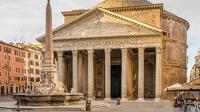Pantheon and its Legend - Rome Walking Tour
Rome, Italy
Trip Type: Cultural Tours
Duration: 3 hours
Visit the legendary Pantheon, discover its interior and visit the papal tombs. then passes through the city of Rome, passing through Piazza Montecitorio, the Mausoleum of Augustus, and finish your tour with the discovery of the Ara Pacis.
More About This Activity All Cultural Tours →
Visit the legendary Pantheon, discover its interior and visit the papal tombs. then passes through the city of Rome, passing through Piazza Montecitorio, the Mausoleum of Augustus, and finish your tour with the discovery of the Ara Pacis.The Pantheon is a building in Rome, on the site of an earlier building commissioned by Marcus Agrippa during the reign of Augustus .The present building was completed by the emperor Hadrian and probably dedicated about 126 AD. He retained Agrippa's original inscription, which has confused its date of constructionIn the aftermath of the Battle of Actium (31 BC), Marcus Agrippa started an impressive building program: the Pantheon was a part of the complex created by him on his own property in the Campus Martius in 29-19 BC, which included three buildings aligned from south to north: the Baths of Agrippa, the Basilica of Neptune, and the Pantheon. It seems likely that the Pantheon and the Basilica of Neptune were Agrippa's sacra privata, not aedes publicae (public temples). This less solemn designation would help explain how the building could have so easily lost its original name and purpose in such a relatively short period of time
The Palazzo Montecitorio is a palace in Rome and the seat of the Italian Chamber of Deputies.The building was designated for public and social functions only due to Innocent XII's firm antinepotism policies which were in contrast to his predecessors. In 1696 the Curia apostolica (papal law courts) was installed there. The Mausoleum of Augustus, also known as Augustus, is an impressive funerary monument of the first century BC, circular, located in Rome. Originally it occupied the northern part of the area called Campus Martius. The mausoleum was begun by Augustus in 28 BC on his return from Alexandria (during his sixth consulate), after conquering Egypt and defeating Marco Antonionella battle of Actium in 31 BC It was during the visit to Alexandria that he was able to see the tomb of Alexander the Great in the Hellenistic style, probably circular, from which he drew inspiration for the construction of his mausoleum. References to Hellenism, in addition to the political choices of Octavian, are confirmed by the decision to erect a dynastic burial is similar to that of Alexander the Great to the Mausoleum of Halicarnassus, built around 350 BC in honor of King Mausolus. The Ara Pacis Augustae is an altar in Rome dedicated to Pax, the Roman goddess of Peace. The monument was commissioned by the Roman Senate on July 4, 13 BC to honor the return of Augustus to Rome after three years in Hispania and Gaul, and consecrated on January 30, 9 BC. The altar reflects the Augustan vision of Roman civil religion. It consists of a traditional open-air altar at its center surrounded by precinct walls which are pierced on the eastern and western ends by openings.
The Palazzo Montecitorio is a palace in Rome and the seat of the Italian Chamber of Deputies.The building was designated for public and social functions only due to Innocent XII's firm antinepotism policies which were in contrast to his predecessors. In 1696 the Curia apostolica (papal law courts) was installed there. The Mausoleum of Augustus, also known as Augustus, is an impressive funerary monument of the first century BC, circular, located in Rome. Originally it occupied the northern part of the area called Campus Martius. The mausoleum was begun by Augustus in 28 BC on his return from Alexandria (during his sixth consulate), after conquering Egypt and defeating Marco Antonionella battle of Actium in 31 BC It was during the visit to Alexandria that he was able to see the tomb of Alexander the Great in the Hellenistic style, probably circular, from which he drew inspiration for the construction of his mausoleum. References to Hellenism, in addition to the political choices of Octavian, are confirmed by the decision to erect a dynastic burial is similar to that of Alexander the Great to the Mausoleum of Halicarnassus, built around 350 BC in honor of King Mausolus. The Ara Pacis Augustae is an altar in Rome dedicated to Pax, the Roman goddess of Peace. The monument was commissioned by the Roman Senate on July 4, 13 BC to honor the return of Augustus to Rome after three years in Hispania and Gaul, and consecrated on January 30, 9 BC. The altar reflects the Augustan vision of Roman civil religion. It consists of a traditional open-air altar at its center surrounded by precinct walls which are pierced on the eastern and western ends by openings.
« Go Back

